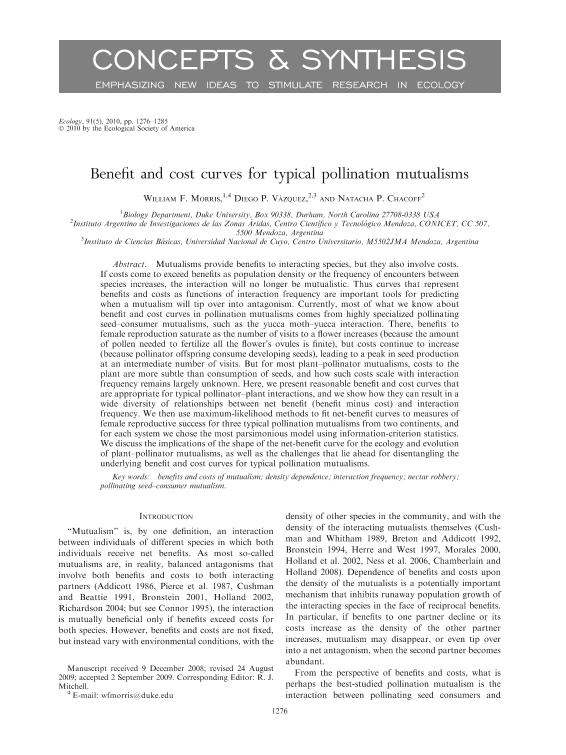Artículo
Benefit and cost curves for typical pollination mutualisms
Fecha de publicación:
05/2010
Editorial:
Ecological Society of America
Revista:
Ecology
ISSN:
0012-9658
Idioma:
Inglés
Tipo de recurso:
Artículo publicado
Clasificación temática:
Resumen
Mutualisms provide benefits to interacting species, but they also involve costs. If costs come to exceed benefits as population density or the frequency of encounters between species increases, the interaction will no longer be mutualistic. Thus curves that represent benefits and costs as functions of interaction frequency are important tools for predicting when a mutualism will tip over into antagonism. Currently, most of what we know about benefit and cost curves in pollination mutualisms comes from highly specialized pollinating seed-consumer mutualisms, such as the yucca moth-yucca interaction. There, benefits to female reproduction saturate as the number of visits to a flower increases (because the amount of pollen needed to fertilize all the flower's ovules is finite), but costs continue to increase (because pollinator offspring consume developing seeds), leading to a peak in seed production at an intermediate number of visits. But for most plant-pollinator mutualisms, costs to the plant are more subtle than consumption of seeds, and how such costs scale with interaction frequency remains largely unknown. Here, we present reasonable benefit and cost curves that are appropriate for typical pollinator-plant interactions, and we show how they can result in a wide diversity of relationships between net benefit (benefit minus cost) and interaction frequency. We then use maximum-likelihood methods to fit net-benefit curves to measures of female reproductive success for three typical pollination mutualisms from two continents, and for each system we chose the most parsimonious model using information-criterion statistics. We discuss the implications of the shape of the net-benefit curve for the ecology and evolution of plant-pollinator mutualisms, as well as the challenges that lie ahead for disentangling the underlying benefit and cost curves for typical pollination mutualisms.
Archivos asociados
Licencia
Identificadores
Colecciones
Articulos(CCT - NOA SUR)
Articulos de CTRO.CIENTIFICO TECNOL.CONICET - NOA SUR
Articulos de CTRO.CIENTIFICO TECNOL.CONICET - NOA SUR
Articulos(IADIZA)
Articulos de INST. ARG DE INVEST. DE LAS ZONAS ARIDAS
Articulos de INST. ARG DE INVEST. DE LAS ZONAS ARIDAS
Citación
Morris, William F.; Vazquez, Diego P.; Chacoff, Natacha Paola; Benefit and cost curves for typical pollination mutualisms; Ecological Society of America; Ecology; 91; 5; 5-2010; 1276-1285
Compartir
Altmétricas




